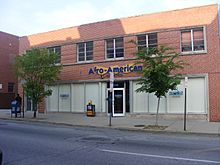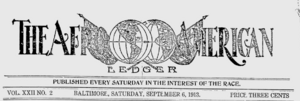Baltimore Afro-American facts for kids
 |
|
 |
|
| Type | Weekly newspaper |
|---|---|
| Format | Broadsheet |
| Publisher | Frances M. Draper |
| Founded | 13 August 1892 |
| Language | English |
| Headquarters | |
| Country | United States |
| ISSN | 2473-5973 |
| OCLC number | 7642696 |
The Baltimore Afro-American, often called The Afro, is a weekly newspaper from Baltimore, Maryland. It's a special newspaper because it focuses on news for African-American communities. It is the main newspaper of the AFRO-American group. This newspaper is the longest-running family-owned African-American newspaper in the United States. It started way back in 1892.
Contents
The Afro-American Newspaper: A Look at Its History
Early Beginnings and Challenges
The Afro-American newspaper first began as The Home Protector in 1889. It was started and edited by Reverend William Alexander. With help from a group of investors, the newspaper changed its name. It became The Afro-American on August 13, 1892.
In 1895, a company called Northwestern Family Supply took over the paper. But this company went bankrupt, and the newspaper almost ended. In 1897, the printing machines for the Afro-American were put up for sale. John H. Murphy Sr., who worked at the paper's printing press, bought the equipment. He borrowed $200 from his wife, Martha Howard Murphy, to do this. Since then, the Afro-American has been owned and run by the Murphy family.
John H. Murphy Sr.'s Vision
John H. Murphy Sr. was born into slavery. He fought in the Civil War with the United States Colored Troops. After the war, he worked many different jobs. He was active in the Bethel African Methodist Episcopal Church in Baltimore. This church was one of the first independent Black churches in the U.S.
Murphy combined his church's newspaper, The Sunday School Helper, with two other church papers. These were The Ledger and The Afro-American. With The Afro-American, Murphy worked to bring the Black community in Baltimore together. He also fought against unfair treatment and worked for better education for children. He spoke out against racism in schools, jobs, housing, and public places. In 1913, he became president of the National Negro Press Association.
Fighting for Voting Rights
In 1905, the Afro-American told its readers to vote against the Poe Amendment. This law was designed to stop Black people from voting. When the Strauss Amendment came along in 1908, the newspaper kept fighting. It spoke out strongly against those who supported the amendment.
Growth and Expansion Under Carl J. Murphy
The newspaper grew much larger after John H. Murphy Sr.'s son, Carl J. Murphy, took charge in 1922. He was the editor for 45 years. He made the paper available in more cities, with nine national editions. At its busiest, the paper printed two weekly editions in Baltimore. It also had regional weekly papers in cities like Washington, DC, Philadelphia, Richmond, Virginia, and Newark, New Jersey. Many Black people from the rural South moved to these northern cities during the Great Migration. Today, the AFRO-American has two city editions: one for Baltimore and one for Washington, D.C.
Supporting Progress and Justice
During the 1924 presidential election, the Afro-American supported the Progressives. This group was led by Elisabeth Coit Gilman and Broadus Mitchell.
Carl Murphy used the newspaper's editorial pages to push for important changes. He wanted African Americans to be hired by Baltimore's police and fire departments. He also pushed for Black people to be part of the government. He worked for the creation of a state-supported university for African Americans.
In the 1930s, The AFRO-American started a successful program called “The Clean Block” campaign. This campaign still exists today. It became an annual event aimed at making inner-city neighborhoods look better and safer. The AFRO-American also fought against the Southern Railroad's use of Jim Crow cars, which separated people by race. They also worked to get equal pay for Maryland's Black schoolteachers.
Reporting on World War II
During World War II, The AFRO-American sent several reporters to different parts of the world. They went to Europe, the Aleutians, Africa, and Japan. This allowed the newspaper to give its readers direct news about the war. One of its reporters, Elizabeth Murphy Phillips Moss, was Carl Murphy's daughter. She was the first Black female war correspondent.
Partnering for Civil Rights
The AFRO-American worked with The National Association for the Advancement of Colored People (NAACP) on many civil rights cases. In the 1930s, the newspaper joined the NAACP in a lawsuit against the University of Maryland Law School. This school had policies that separated students by race. Their combined efforts helped lead to the U.S. Supreme Court's 1954 decision. This important decision made segregated public schools illegal. The AFRO-American also supported actor and singer Paul Robeson and sociologist W.E.B. DuBois. This was during the anti-Communist campaigns of the Joseph McCarthy era.
Notable Journalists and Artists
The AFRO-American has employed many important Black journalists and thinkers. These include Langston Hughes, William Worthy, and J. Saunders Redding. In the mid-1930s, it became the first Black newspaper to hire a female sportswriter. Lillian Johnson and Nell Dodson joined its staff. The famous artist Romare Bearden started his career as a cartoonist at The AFRO-American in 1936.
Sam Lacy was hired as the paper's sports editor in 1943. He wrote a weekly column called ”A to Z”. In this column, he pushed for professional sports to allow Black athletes to play. Lacy and other sports writers helped open doors for Black athletes. After Carl Murphy passed away in 1967, his daughter Frances L. Murphy II became chairman and publisher. In 1974, John Murphy III, Carl's nephew, took over as chairman and later as publisher.
Both John H. Murphy Sr. and his son Carl J. Murphy have been honored for their work. They were added to the MDDC Press Association's Hall of Fame in 2008 and 2015. This was to recognize their important contributions to journalism and publishing.
The Afro Today
Today, The AFRO is led by the 4th and 5th generations of John H. Murphy Sr.'s family. It works with Morgan State University's School of Global Journalism and Communication. This partnership gives real-world experience to students who want to become journalists or public relations specialists.
University Collaborative Archival Project
In November 2007, five students from Baltimore universities were chosen for a special project. These students were from Johns Hopkins University, Morgan State University, and Goucher College. They began working on a project to explore the newspaper's old records. These records are kept at the newspaper's headquarters. They include old writings, articles, photos, and newspaper clippings from when the paper first started. The goal of this project is to find important collections, organize them, and create an online database. This database will help people search for and learn from these historical materials.
See also
 In Spanish: Afro-American para niños
In Spanish: Afro-American para niños
- Media in Baltimore
- List of newspapers in Maryland


